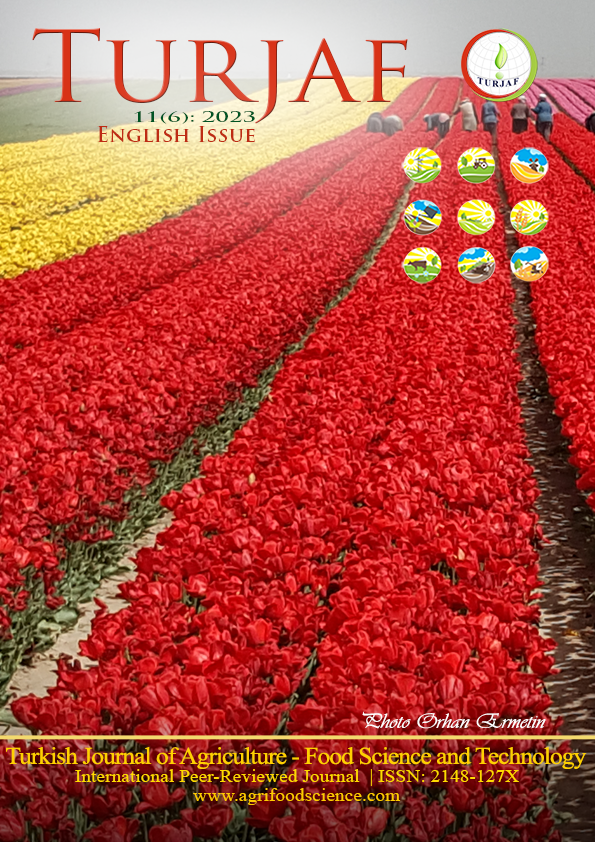Acute Toxicity and Antioxidant Activity of Algerian Citrus deliciosa
DOI:
https://doi.org/10.24925/turjaf.v11i6.1106-1109.5984Anahtar Kelimeler:
Ethanol extract- Citrus deliciosa- antioxidant activity- acute toxicity- flavonoids.Özet
Our phytochemical study focused on the leaves of Citrus deliciosa of Algerian origin, in order to evaluate its antioxidant activity and its acute toxicity, using scavenger activity of DPPH radicals, ABTS and acute toxicity. The ethanol extract of Citrus deliciosa contains 85.62 ± 2.24 μg /mg dried matter and 3.02 ± 0.17 μg/mg dried matter. The antioxidant activity was confirmed against the DPPH radical (IC50 = 252.07 ± 0.02 μg /mL) and ABTS (IC50 = 398.26 ± 0.01 μg /mL). No mortality or abnormal behavior was observed in mice at oral doses less of 1600 mg/kg. According to the results obtained, Citrus deliciosa leaves exhibit significant antioxidant activity and are safe at levels lower than 1600 mg/kg B.W., which supports their application in phytotherapy, pharmaceutical biotechnology, and the food sector for therapeutic or preventive purposes.
Referanslar
Abdou Bouba A, Njintang, YN, Scher J, Mbofung C M F. 2010. Phenolic compounds and radical scavenging potential of twenty Cameroonian spices. Agric. Biol. J. N. Am., 1(3), 213-224. DOI: 10.5251/abjna.2010.1.3.213.224
Aouachria S, Boumerfeg S, Benslama A, Benbacha F, Guemmez T, Khennouf S, ... Baghiani A. 2017. Acute, sub-acute toxicity and antioxidant activities (in vitro and in vivo) of Reichardia picroide crude extract. Journal of ethnopharmacology, 208, 105-116. DOI: 10.1016/j.jep.2017.06.028
Boussoualim N, Baghiani A, Krache I, Trabsa H, Khennouf S, Arrar L. 2015. Inhibitory effects of Anchusa azurea extracts on xanthine oxidase activity and its hypouricemic effects on mice. International Journal of Pharmacy and Pharmaceutical Sciences, 7(8), 195-199.
Ghasemi K, Ghasemi Y, Ebrahimzadeh MA. 2009. Antioxidant activity, phenol and flavonoid contents of 13 citrus species peels and tissues. Pak J Pharm Sci, 22(3), 277-281.
Hemalatha S, Lalitha P, Arulpriya P. 2010. Antioxidant activities of the extracts of the aerial roots of Pothosaurea (Linden ex Andre). Der Pharma Chemica, 2(6), 84-89.
Huang Y, Tan A, Shen Y, Lu J. 1998. Scavenging effect of total flavonoids of lycium barbarum L on active oxygen radicals and inhibitory effects on heat output from L1210 cells. Wei sheng yan jiu, Journal of hygiene research, 27(2), 109-11.
Karimi E, Oskoueian E, Hendra R, Oskoueian A, Jaafar HZ. 2012. Phenolic compounds characterization and biological activities of Citrus aurantium bloom. Molecules, 17(2), 1203-1218.
Lagha-Benamrouche S, Madani K. 2013. Phenolic contents and antioxidant activity of orange varieties (Citrus sinensis L. and Citrus aurantium L.) cultivated in Algeria: Peels and leaves. Industrial Crops and Products, 50,723-730.
Menichini F, Loizzo MR, Bonesi M , Conforti F, De Luca D, Statti GA, ... Tundis R. 2011. Phytochemical profile, antioxidant, anti-inflammatory and hypoglycemic potential of hydroalcoholic extracts from Citrus medica L. cv Diamante flowers, leaves and fruits at two maturity stages. Food and Chemical Toxicology, 49(7), 1549-1555.
Manthey JA, Guthrie N, Grohmann K. 2001. Biological properties of citrus flavonoids pertaining to cancer and inflammation. Current medicinal chemistry, 8(2), 135-153.
Mohammed FS, Korkmaz N, Doğan M, Şabik AE, Sevindik M. 2021. Some medicinal properties of Glycyrrhiza glabra (Licorice). Journal of Faculty of Pharmacy of Ankara University, 45(3), 524-534.
Mohammed FS, Sevindik M, Uysal I, Sevindik E, Akgül H. 2022. A Natural Material for Suppressing the Effects of Oxidative Stress: Biological Activities of Alcea kurdica. Biology Bulletin, 49(Suppl 2), S59-S66.
Mohammed FS, Uysal I, Sevindik M. 2023. A review on antiviral plants effective against different virus types. Prospects in Pharmaceutical Sciences, 21(2), 1-21.
Nenadis N, Wang LF, Tsimidou M, Zhang HY 2004. Estimation of scavenging activity of phenolic compounds using the ABTS•+ assay. Journal of agricultural and food chemistry, 52(15), 4669-4674.
Newman DJ, Cragg GM. 2020. Natural products as sources of new drugs over the nearly four decades from 01/1981 to 09/2019. Journal of natural products, 83(3), 770-803.
OECD (Organization for Economic Co-operation and Development). Guidelines for the testing of chemicals. Acute Oral. Toxicity Proced, 425, 427. 2008.
Tripoli E, La Guardia M, Giammanco S, Di Majo D, Giammanco M. 2007. Citrus flavonoids: Molecular structure, biological activity and nutritional properties: A review. Food chemistry, 104(2), 466-479. https://doi.org/10.1016/j.foodchem.2006.11.054
Rice-Evans CA, Miller NJ, Paganga G. 1996. Structure-antioxidant activity relationships of flavonoids and phenolic acids. Free radical biology and medicine, 20(7), 933-956.
Sevindik M, Onat C, Mohammed FS, Uysal İ, Koçer O. 2023. Antioxidant and antimicrobial activities of White Radish. Turkish Journal of Agriculture-Food Science and Technology, 11(2), 372-375.
Sevindik M, Akgul H, Pehlivan M, Selamoglu Z. 2017. Determination of therapeutic potential of Mentha longifolia ssp. longifolia. Fresen Environ Bull, 26(7), 4757-4763.
Şahin S. 2015. A novel technology for extraction of phenolic antioxidants from mandarin (Citrus deliciosa Tenore) leaves: Solvent-free microwave extraction. Korean Journal of Chemical Engineering, 32(5), 950-957.
Siahpoosh A, Javedani F. 2012. Antioxidative capacity of Iranian Citrus deliciosa peels. Free Radicals and Antioxidants, 2(2), 62-67. https://doi.org/10.5530/ax.2012.2.2.11
Uysal I, Koçer O, Mohammed FS, Lekesiz Ö, Doğan M, Şabik AE, Sevindik, E, & Gerçeker FÖ, Sevindik, M. (2023). Pharmacological and Nutritional Properties: Genus Salvia. Advances in Pharmacology and Pharmacy, 11(2), 140-155.
Velioglu Y, Mazza G, Gao L, Oomah BD 1998. Antioxidant activity and total phenolics in selected fruits, vegetables, and grain products. Journal of agricultural and food chemistry, 46(10), 4113-4117. https://doi.org/10.1021/jf9801973
Yacine B, Noureddine B, Mustapha T, Samira M, Bachra K. 2013. Acute and subchronic toxicity study of Nigella damascena methanolic seed extract in mice. Int. J. Pharm. Bio. Sci, 4(2), 413-419.
İndir
Yayınlanmış
Nasıl Atıf Yapılır
Sayı
Bölüm
Lisans
Bu çalışma Creative Commons Attribution-NonCommercial 4.0 International License ile lisanslanmıştır.

























